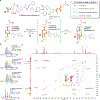Interception of the Bycroft-Gowland Intermediate in the Enzymatic Macrocyclization of Thiopeptides
- PMID: 32609512
- PMCID: PMC7429253
- DOI: 10.1021/jacs.0c05639
Interception of the Bycroft-Gowland Intermediate in the Enzymatic Macrocyclization of Thiopeptides
Abstract
Thiopeptides are a broad class of macrocyclic, heavily modified peptide natural products that are unified by the presence of a substituted, nitrogen-containing heterocycle core. Early work indicated that this core might be fashioned from two dehydroalanines by an enzyme-catalyzed aza-[4 + 2] cycloaddition to give a cyclic-hemiaminal intermediate. This common intermediate could then follow a reductive path toward a dehydropiperidine, as in the thiopeptide thiostrepton, or an aromatization path to yield the pyridine groups observed in many other thiopeptides. Although several of the enzymes proposed to perform this cycloaddition have been reconstituted, only pyridine products have been isolated and any hemiaminal intermediates have yet to be observed. Here, we identify the conditions and substrates that decouple the cycloaddition from subsequent steps and allow interception and characterization of this long hypothesized intermediate. Transition state modeling indicates that the key amide-iminol tautomerization is the major hurdle in an otherwise energetically favorable cycloaddition. An anionic model suggests that deprotonation and polarization of this amide bond by TbtD removes this barrier and provides a sufficient driving force for facile (stepwise) cycloaddition. This work provides evidence for a mechanistic link between disparate cyclases in thiopeptide biosynthesis.
Conflict of interest statement
The authors declare no competing financial interests.
Figures




References
-
- Mark C Bagley; James W Dale; Eleanor A Merritt, A.; Xiong X Thiopeptide Antibiotics. Chem. Rev. 2005, 105 (2), 1–30. - PubMed
-
- Just-Baringo X; Albericio F; Álvarez M Thiopeptide Engineering: a Multidisciplinary Effort Towards Future Drugs. Angew. Chem. Int. Ed. 2014, 53 (26), 6602–6616. - PubMed
-
- Shen X; Mustafa M; Chen Y; Cao Y; Gao J Natural Thiopeptides as a Privileged Scaffold for Drug Discovery and Therapeutic Development. Med. Chem. Res. 2019, 28 (8), 1063–1098.

